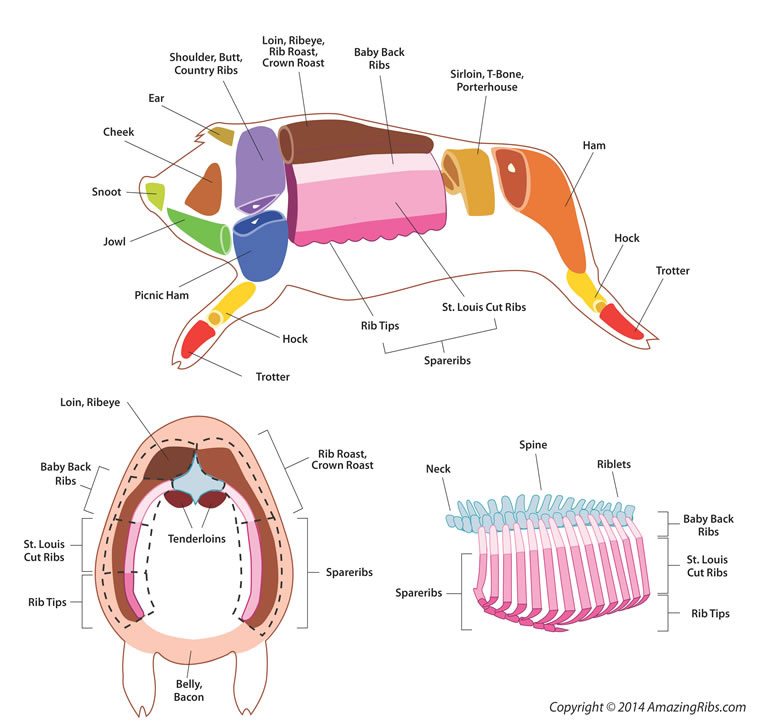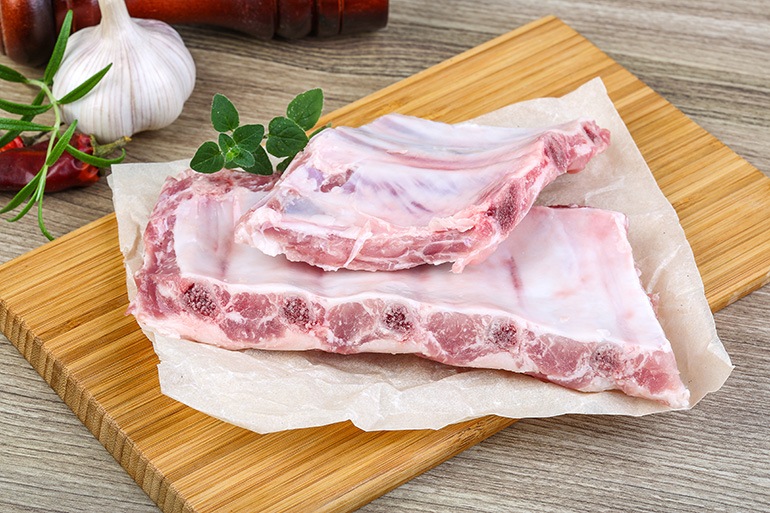Do you always go to the butcher store and wonder what kind of ribs you are going to take? Many people barely know the difference. In fact, to most, ribs are just ribs. Today we are going to see the difference between spare ribs and baby back ribs. So that next time, you can go surprise your guy at the meat store with an impressive, “Can I get a rack of finely chopped St. Louis-style ribs?” This will most definitely to help us understand the most preferred type of rib for a certain instance.
Quick Navigation
How to Tell Whether It’s a Spare or Baby Back Rib?


If you have been keen enough, you will notice that in the universe of ribs, the catch lies in the location. All the kinds of coolest meat are obtained from the bellies of the animal. No wonder bacon tastes like heaven. Spare ribs come from the belly as well. They are characterized by lots of fat, meatiness and are very appetizing.
If you are out to find a deep flavor, this is the choice to go for. A slab of spare ribs reveals the ends of bones along one side of the edge and some marrow as well. The other end with no bones sticking out is given the name rib tips and it comes from the chest.
However, our patience comes to test here. Spare ribs can take up to 8 hours to prepare, but at the end of it all, your result will be a savory tender and amazingly succulent chunk of ribs. You can get them from two-pound slabs or more. Besides the fact that they take less finesse to prepare, they are generally preferred by owners of barbecue joints because they are sold modestly. Spare ribs are cheaply sold, unlike their baby backs counterparts.
Truth About Baby Back Ribs
Baby backs go by other names such as loin back ribs or back ribs. Back ribs are sliced off from the point the rib meets the spine after removal of the loin. How did they come to get named baby back ribs? It’s only because they are tinier as compared to the thicker spare ribs.
A baby rib is just but a pork chop with most of the loin meat cut off. It is this aspect that makes them so tender and so lean and for this, they are usually in higher demand than the spare ribs. This makes them even more costly.
Baby ribs assume the shape of a curve of a hockey stick and are easily identifiable.
The fact that the larger and tougher spare ribs are cooked for longer means they need to be made so tender so they can be as tantalizing as their baby back ribs complements. The difference between spare ribs and baby back ribs may not seem so evident, but the sections from where they are cut off actually make the whole difference evident.


How Did the Names Come to Be?
A point to note is the fact that not all animals have the same kind of names for the chunks of meat cut from a specific part of their bodies. The difference could also arise depending on the country of residence. For example, a rack of lamb is what a rib roast is to beef and what a pork crown is to pigs. Pork spare ribs are almost similar to beef short ribs but you would never find beef spare ribs because it is inexistent.
Pigs normally have 14 rib bones which are attached to the spine and popularly divided into four types of cuts. Namely, baby back ribs, spare ribs, rib tips and St. Louis cut ribs. However, there are other specific cuts to which we will look at as time goes by.
Can They Be Used Interchangeably?
The difference between baby back ribs and spare ribs as we have seen comes from when we are cutting them off specific sections. Baby back ribs may be used in place of the spare ribs. However, the baby back ribs are tinier and you will need a very large amount of it to substitute for the huge chunks of the spare ribs.
The spare ribs take a long time to cook, almost double the cooking time for the baby back ribs. you can experiment with it, but care should be taken to maintain the oven at 300 degrees Fahrenheit.
Trends Over Time
With time there have come developments which have even brought more diversity and more difference between the baby back ribs and spare ribs. Boneless baby back ribs, which are attached to the loin muscle, just means more meat has been left on the ribs. There are more interesting facts to learn about spare ribs and they can be found in detail here.
There may also arise other smaller cuttings of ribs and here you will find more specific names such as the St. Louis style ribs. They are chopped off from the spare ribs and the outcome is a more even and rectangular-shaped rack.
Why are there finer chops of ribs? Apparently, the usual cut of spare ribs doesn’t give room for keen preparation, unlike the specific cut. The St. Louis cut which exhibits uniformity in size and shape makes it easier to cook and ultimately the same applies to serving time. However, more details mean more expertise and therefore care should be taken when trying out the different cuts of meat.
Conclusion
Spare ribs, approximately weighing 2 to 4 pounds, composed of bone and cartilage normally feeds two people. Each slab of baby back, however, may weigh up to 2 pounds, half of its composition being bone, can feed a number of people. You can now comfortably tell which type of rib cut is ideal for your family, and which one to go for when the party is large.
The fact that baby backs can withstand long hours of grilling makes them ideal for many recipes. Cooking them slowly while marinating them ensures their tenderness. Spare ribs, on the other hand have a mixture of fat and meat which makes them easy to tender, despite the slow-cooking.
Care should be taken when selecting the type of cut you are going to need to ensure you achieve your desired taste. We hope this article has clearly outlined the difference between spare ribs and baby back ribs.
Got any questions in mind? You can leave them in our comments section and we will get back to you as soon as we can. Enjoy!

